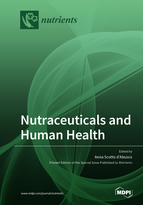Nutraceuticals and Human Health
A special issue of Nutrients (ISSN 2072-6643). This special issue belongs to the section "Nutrition and Public Health".
Deadline for manuscript submissions: closed (31 July 2020) | Viewed by 99389
Special Issue Editor
Special Issue Information
Dear Colleagues,
In this Special Issue of Nutrients, we would like to collect papers on the health-promoting effect of nutraceuticals, taking into account both healthy people and patients affected by different pathologies. At present, the administration of nutraceuticals is very diffused to treat diseases, to contrast aging and stress, and to serve as dietary supplements for athletes.
Several studies on compositions, formulations, and nutraceutical delivery have been conducted so far, with inconsistent outcomes. Particularly, the debate on the secondary and rare adverse effects of some nutraceuticals and their safety and effectiveness is very interesting. In recent years, the health claims of a large number of nutraceuticals were not approved by FDA and EFSA agencies. Therefore, further research is required to analyze more in depth the mechanism of action of molecules to be used as nutraceuticals.
We welcome different types of manuscript submissions, including original research articles and up-to-date reviews (systematic reviews and meta-analyses).
Potential topics may include but not be limited to the study of molecules extracted from plants used to treat different types of pathologies as inflammatory diseases, bone diseases, cancer, cardiovascular disease, obesity and weigth control, diabetes, immunometabolism, hyperlipidemic diseases, skin diseases, and quality of life.
Dr. Anna Scotto D'Abusco
Guest Editor
Manuscript Submission Information
Manuscripts should be submitted online at www.mdpi.com by registering and logging in to this website. Once you are registered, click here to go to the submission form. Manuscripts can be submitted until the deadline. All submissions that pass pre-check are peer-reviewed. Accepted papers will be published continuously in the journal (as soon as accepted) and will be listed together on the special issue website. Research articles, review articles as well as short communications are invited. For planned papers, a title and short abstract (about 100 words) can be sent to the Editorial Office for announcement on this website.
Submitted manuscripts should not have been published previously, nor be under consideration for publication elsewhere (except conference proceedings papers). All manuscripts are thoroughly refereed through a single-blind peer-review process. A guide for authors and other relevant information for submission of manuscripts is available on the Instructions for Authors page. Nutrients is an international peer-reviewed open access semimonthly journal published by MDPI.
Please visit the Instructions for Authors page before submitting a manuscript. The Article Processing Charge (APC) for publication in this open access journal is 2900 CHF (Swiss Francs). Submitted papers should be well formatted and use good English. Authors may use MDPI's English editing service prior to publication or during author revisions.
Keywords
- Herbal extracts
- Nutraceutical screening
- Biochemical analyses
- Cell culture models
- In vivo studies
- Inflammation
- Bone diseases
- Cancer
- Immunometabolism
- Health claims







